Let’s face it: Hydrangeas are surreal. Really, every blossom-bedecked bush takes a giant leap from reality into a fantasy world where larger-than-life flowers rule. Smothered with puffy, sky blue orbs of rare shades that linger in suspended splendor for weeks, bigleaf hydrangeas seem like something straight off the set of La La Land. The blossom load is so dense and dramatic that a well-grown hydrangea will show only a sneak peek of its underlying greenery when the blooming cycle is going full tilt. A bountiful hydrangea continues the show for months of continuous awe. Whether you’re looking for a foundation planting candidate, a blooming hedge, a remarkable accent plant, or something to supply ingredients for an Insta-worthy bodacious bouquet, bigleaf hydrangeas are your dream come true.
WHY BIGLEAF HYDRANGEAS?
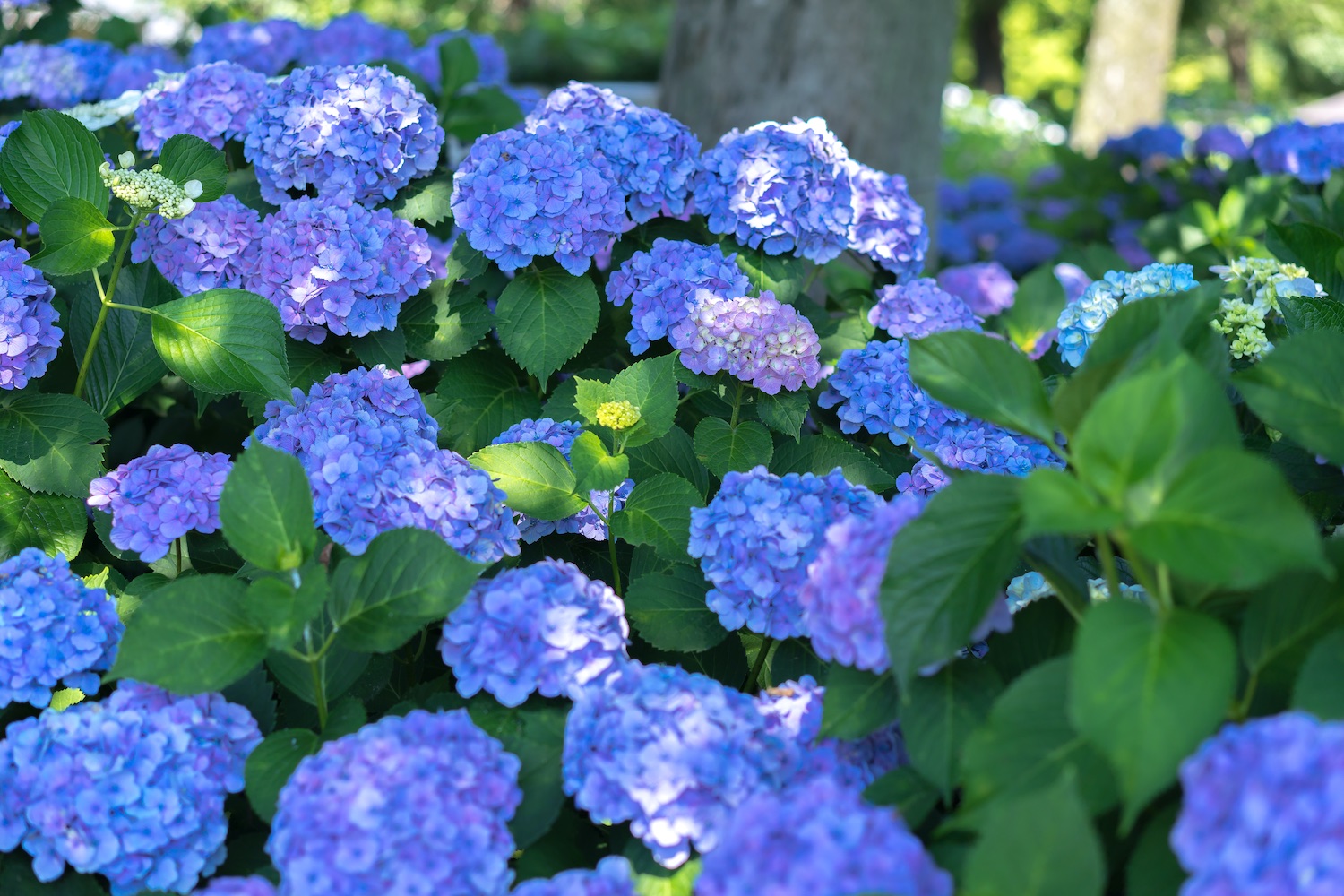
Photo by Shonenphoto
Although several species of hydrangeas are available, Japanese native Hydrangea macrophylla (aka bigleaf hydrangeas) wins the popularity poll by a long shot. Although the bigleaf hydrangea’s flower color range is expanding daily, it’s the sparkling baby blue versions that hold pride of place in the average gardener’s heart. Mention legacy blue hybrids, and the names ‘Nikko Blue’, ‘Penny Mac’, ‘All Summer Beauty’, ‘Mathilda Gutges’, and Endless Summer® The Original are bound to be heard. More recently introduced supernovas include Proven Winners’ ‘Blue Jangles’®, ‘Rhythmic Blue’® in the Let’s Dance® series, and iBloom® ‘Azure Skies’™. But those are just a handful of notables in the true blue hue. Additionally, bigleaf hydrangeas come in purple, white, pink, red, mauve, and bicolors.
WHAT MAKES HYDRANGEA FLOWERS BLUE?
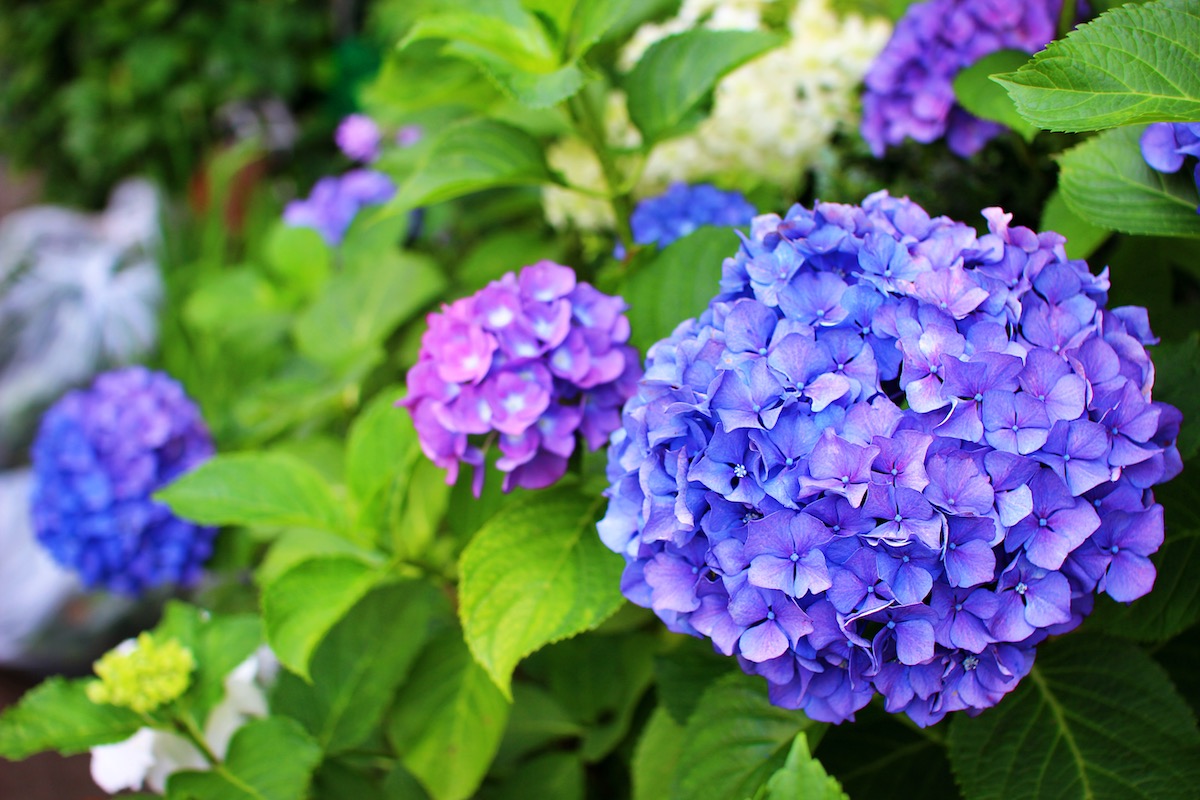
Photo by Naima Niemand
For many of us, bigleaf hydrangeas are a wish but not a promise. Unfortunately, not everyone can achieve their dream color. It’s the presence of aluminum in the soil—specifically in soils with an acid pH—that gives the sepals their true blue hue. If your soil is alkaline, those sepals will not attain the coveted sky blue, no matter which hybrid you are growing. Hydrangea macrophylla is also the least hardy of the hydrangea clan making it “iffy” where temperatures dip (although breeders are working on that trait). That’s one reason why these hydrangeas are associated with the shore. Moderate coastal environments tend to provide optimally mild weather. However, there’s another perk associated with coastal regions. They offer the perfect soil to host bigleaf hydrangeas. If Cape Cod is famous for its true blue hydrangeas, that’s because their soils contain aluminum and are notoriously acidic. But then, hydrangeas of any shade seem to love the Cape. To turn your hydrangea flowers blue—or a more intense blue—you need to amend your soil with aluminum sulfate (note that this only works with bigleaf hydrangeas). Available at most garden centers and big-box stores, it not only lowers the soil pH but also adds the needed aluminum. Follow the package directions and note that you may not see results until the following year.
MOPHEADS VS. LACE CAPS

Photo by Yamasa
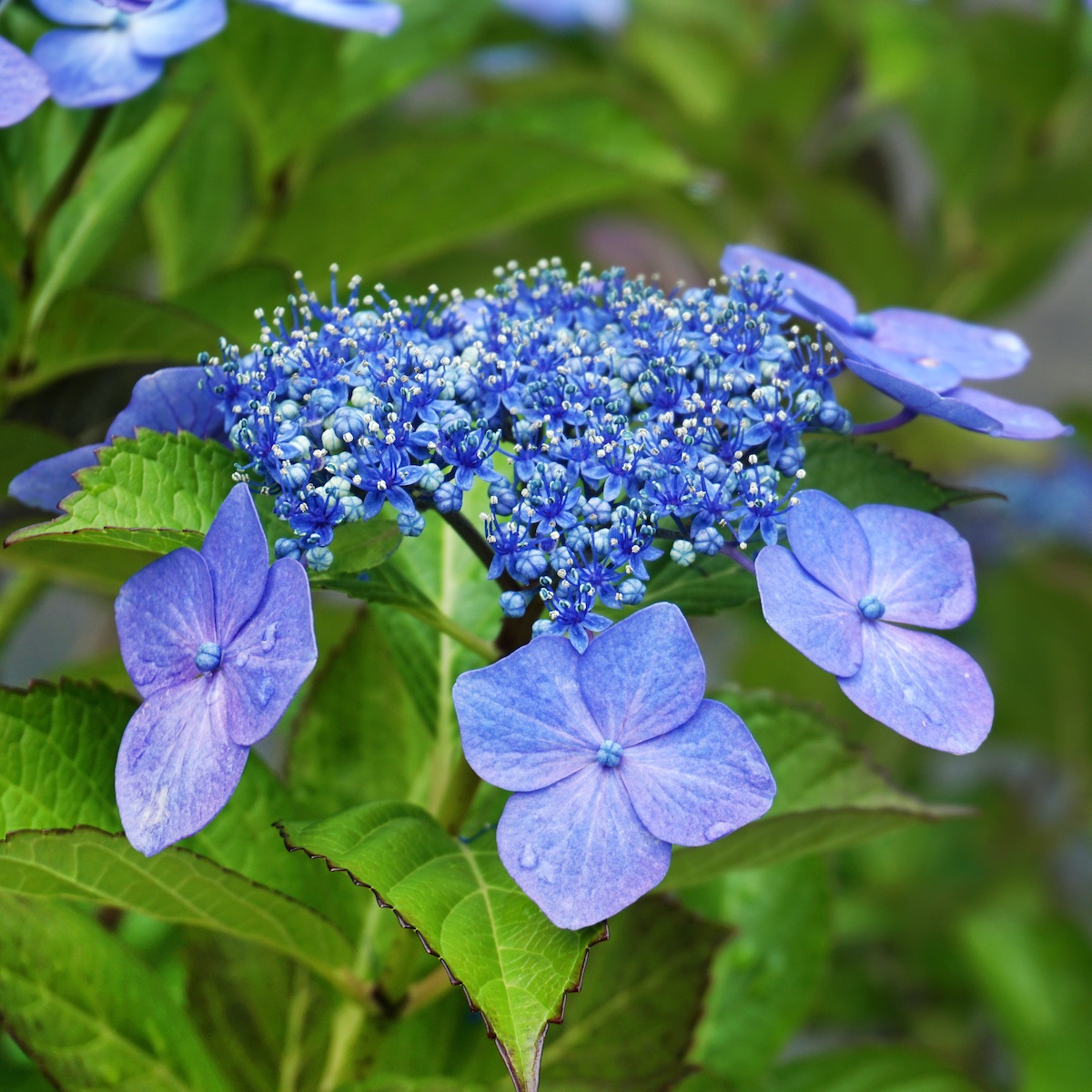
Photo by Sana Moo
Just to define our terms, another little secret of bigleaf hydrangeas is that the poufy, tissue-paper-like orbs we covet so dearly are not actually a nest of fertile flowers. Two types of bigleaf hydrangeas rule the trade. In the typical mophead, the corymb (or cluster, if you will) is formed by the sepals of sterile florets. (In the recent book Hydrangeas: Beautiful Varieties for Home and Garden (Gibbs-Smith, 2020), Naomi Slade aptly makes the comparison to snowballs.) Because those flowers are sterile and are not driven by the timetable of fertility and seed production, they linger longer. On the other hand, in the lace-cap presentation, a fluffy nest of tiny fertile flowers is surrounded by a ring of sterile petal-like sepals. Their lifespan is not quite so lengthy. Both the mophead and lace-cap versions are equally awesome; however, for the cut flower market, it’s the long-lasting, massive mopheads with their signature drama and girth that rule the venue—for good reason. They’re plump and they’re crowd pleasers. What’s not to love?
Hydrangeas enjoy an ardent fan club, and they have attracted several spokespeople who gladly serve as cheerleaders. Dr. Michael A. Dirr, professor of horticulture at the University of Georgia, frequent lecturer on the species, and author of The Hydrangea Book: The Authoritative Guide (Stipes Publishing, 2021), goes all out for hydrangeas. Another source of information and inspiration is Mal Condon, curator of hydrangeas at Heritage Museums and Gardens in Sandwich, MA. Taking advantage of the auspicious conditions on Cape Cod, Heritage Gardens packs its displays full of hydrangeas, and Mal—with 50 years of hydrangea growing under his suspenders—serves as the eager expert. In addition to a historic collection of legacy varieties, the official North American Hydrangea Test Garden is also in residence with hundreds of cultivars on display. Given the scope of these two venues, visitors can easily experience the full breadth of bigleaf hydrangeas, especially during the Hydrangea Festival held during the second week of July (July 7-16, 2023).
REBLOOMING HYDRANGEAS
Mal Condon keeps his finger on the pulse of bigleaf hydrangea breeding, and he is quick to point out that the trend is moving in the right direction for wannabee growers who might not live in Zone 7, where bigleaf hydrangeas are reliably bud hardy. The heartbreak that often happens with bigleaf hydrangeas occurs when their woody stems might survive a long, cold winter, but the flower buds are zapped by the cold and desiccating winds. Needless to say, breeders have been laboring to make the substantial flowerheads of bigleaf hydrangeas within the realm of us all. Their solution is what they call “reblooming hydrangeas,” a trend that began in 1998. As part of the answer, breeders use the more stoic hardiness of Hydrangea serrata (a species native to the colder mountainous regions of Japan) to insert vigor into their hybrids. As Mal Condon sums it up, “They’re building a better macrophylla.”

Photo courtesy of Proven Winners® ColorChoice®
Proven Winners Let’s Dance® Sky View® Hydrangea
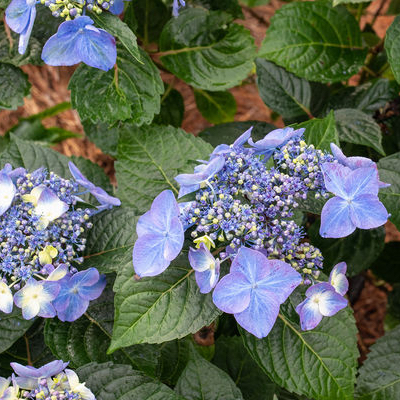
Photo courtesy of Bailey Nurseries
Endless Summer® Pop Star® Hydrangea
Reblooming from a bigleaf hydrangea’s standpoint means that you get two shots at flowers. Early in the season (usually late June or early July at Heritage Gardens), surviving buds on the old wood perform—if you’re lucky and winter wasn’t too cruel. More reliably, a set of buds hidden down closer to the ground and therefore protected from the cold and winds of winter gears up later in July to unfold through August and September. With the Proven Winners’ Let’s Dance® series, Bailey Nurseries’ Endless Summer® series, and Monrovia’s Seaside Serenade® series, a better, hardier bigleaf hydrangea is coming onto the market.
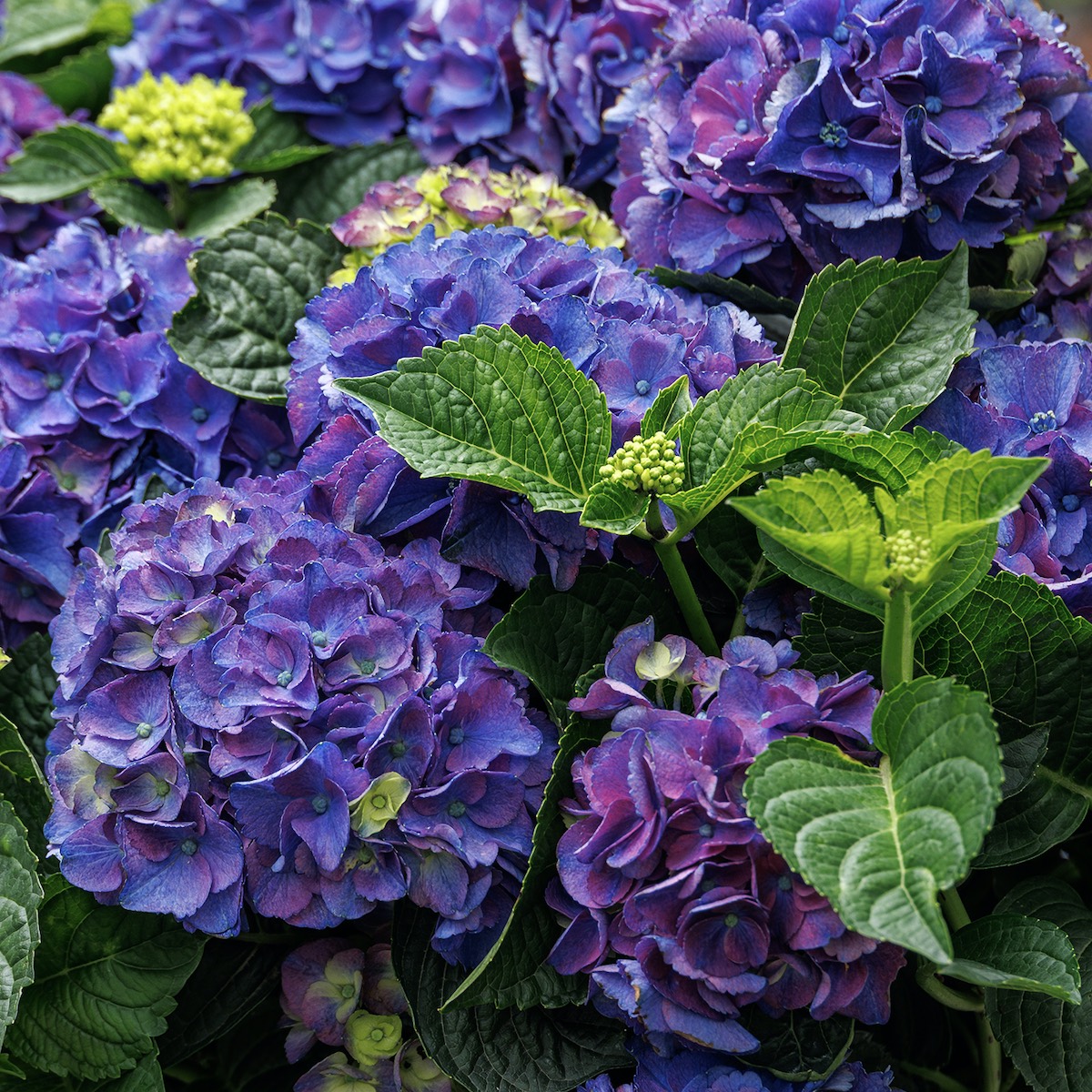
Photo courtesy of Monrovia
Seaside Serenade® Newport Hydrangea
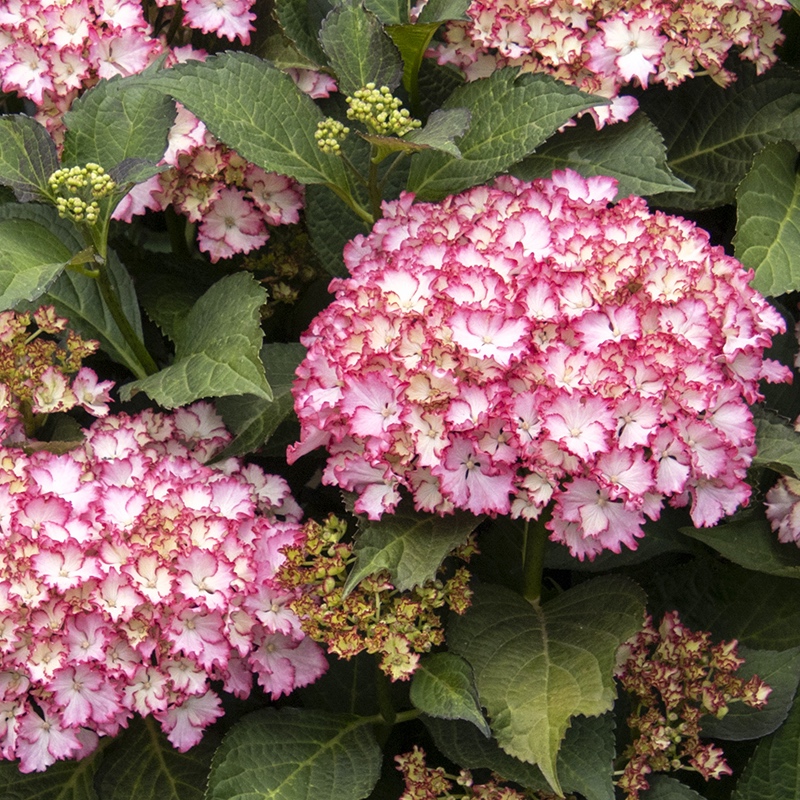
Photo by Doreen Wynja, courtesy of Monrovia
Seaside Serenade® Fire Island Hydrangea
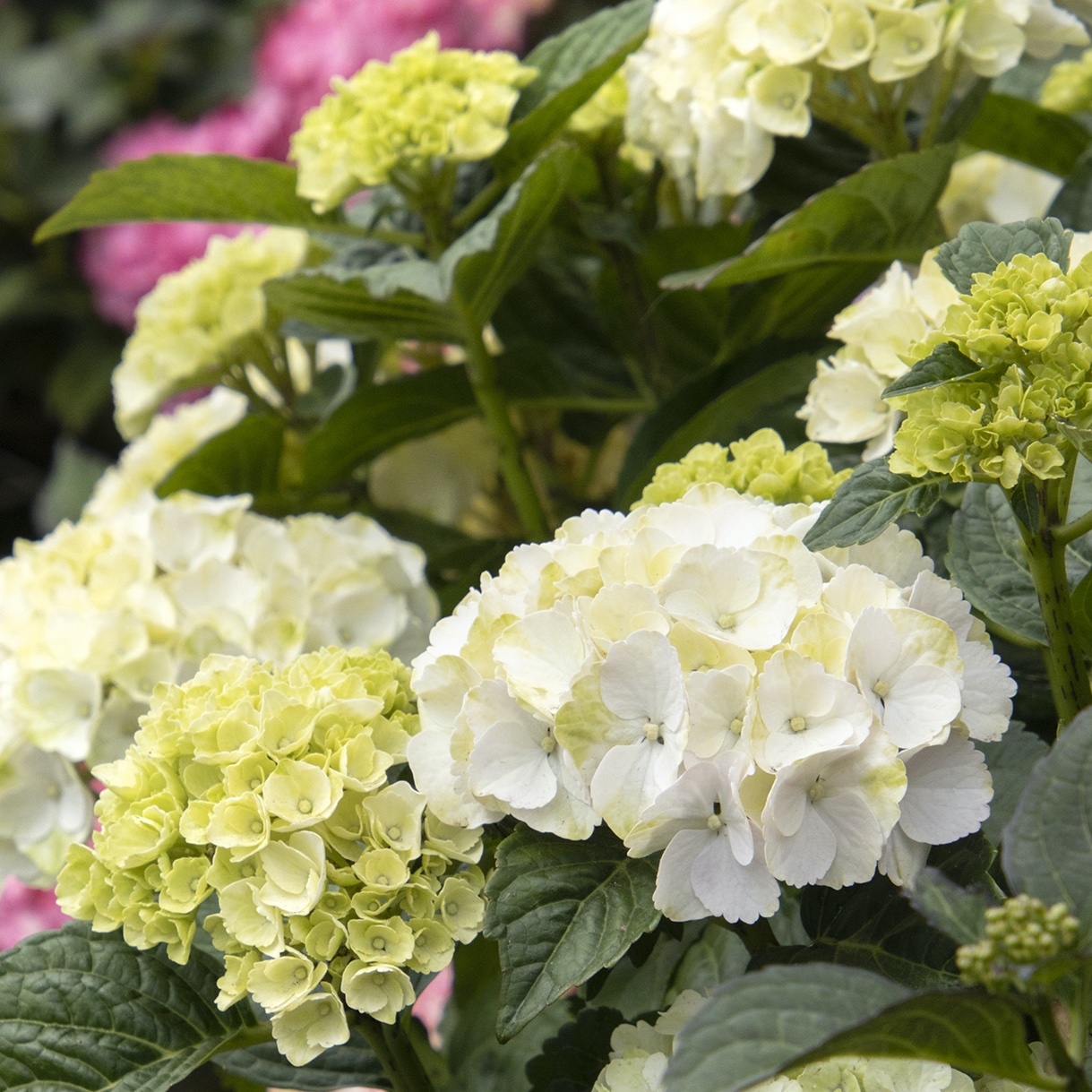
Photo by Doreen Wynja, courtesy of Monrovia
Seaside Serenade® Cape Lookout Hydrangea
Georgia Clay of Monrovia is particularly excited about ‘Newport’ (purple), ‘Fire Island’ (bicolor white with rosy red edges), and ‘Cape Lookout’ (white)—all tetraploids in the Seaside Serenade® series. “They just nail it,” she says as she sums up their vigor. And temperatures are not the only arena in which the plants have been improved. “Thanks to their leathery leaves and strong flowers, they stand up to weather. These are amazing plants,” Georgia adds. Plus, the Seaside Serenade® series lends itself to cuts. “They last a really long time,” says Georgia.
WATERING BIG-LEAF HYDRANGEAS
According to Mal Condon, irrigation can be a major issue for bigleaf hydrangeas, and he advises against aerial irrigation. Instead, to prevent leaf spotting and promote more efficient water utilization, Mal suggests drip irrigation. But he also warns against the understandable reaction when homeowners witness wilt at midday and rush to the rescue with water. Wilting is part of a bigleaf hydrangea’s solution to high temperatures—it does not necessarily express the plant’s need or desire for additional water. When temperatures moderate and the sun lowers, the plant will naturally bounce back. That said, bigleaf hydrangeas can tolerate both sunny and partially shaded growing conditions. However, dense shade will impact the quality and quantity of the flowerheads.
GROWING HYDRANGEAS IN CONTAINERS
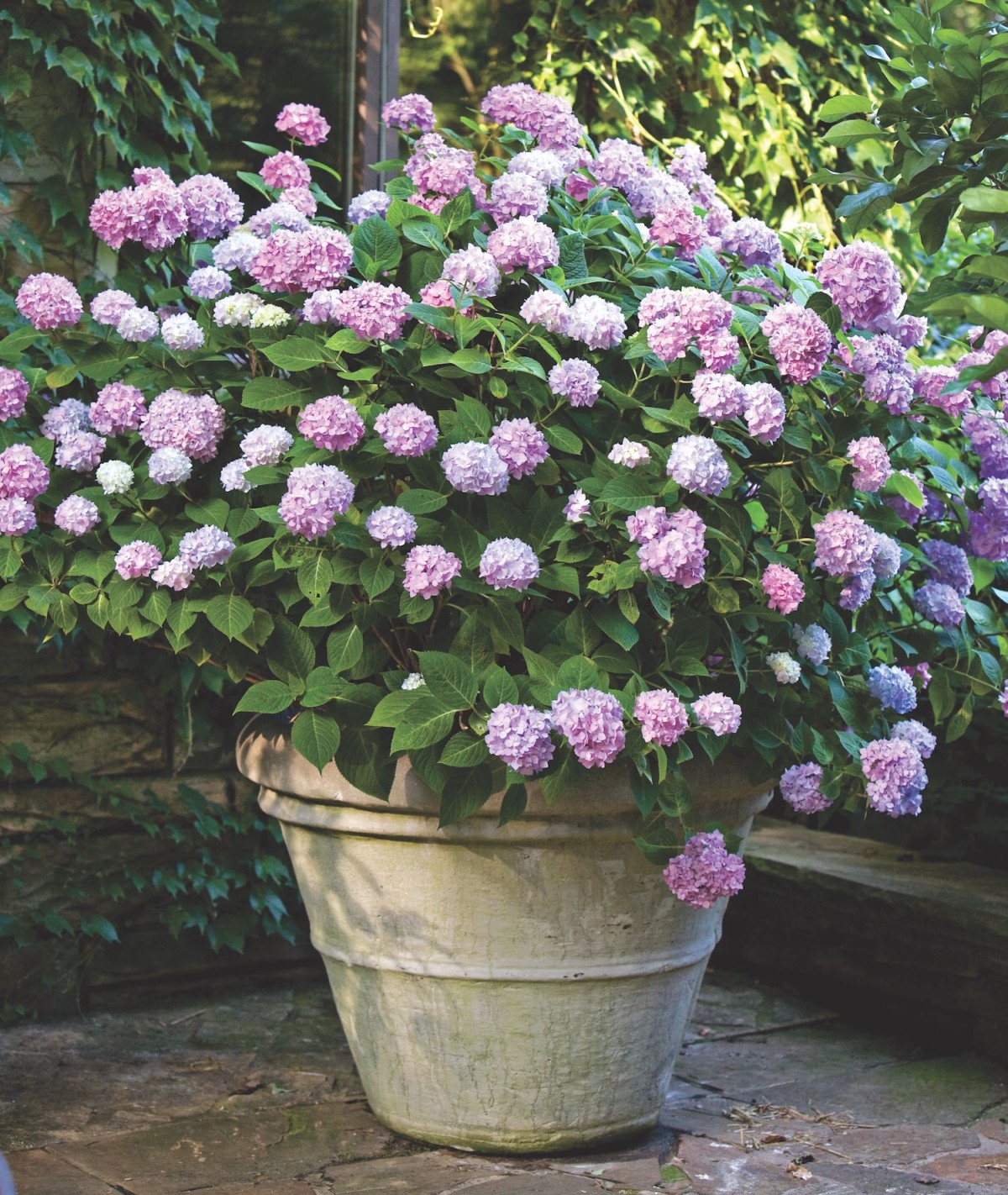
Photo by Alecia Lauren
Large container-grown mophead hydrangea ‘Generale Vicomtesse de Vibraye.'
Mal Condon is also an advocate for growing bigleaf hydrangeas in containers. Although the plants sold for Easter and Mother’s Day early in the season might not be sufficiently hardy to endure winter in many regions, they make beautiful container plants if sheltered from winter’s impact. Another solution to keep tender varieties of bigleaf hydrangeas as part of your scene might be to wrap them in protective coverings through winter when the dormant plant only needs minimal light. Mulching and burying in leaf litter are also solutions.
HYDRANGEAS AS CUT FLOWERS
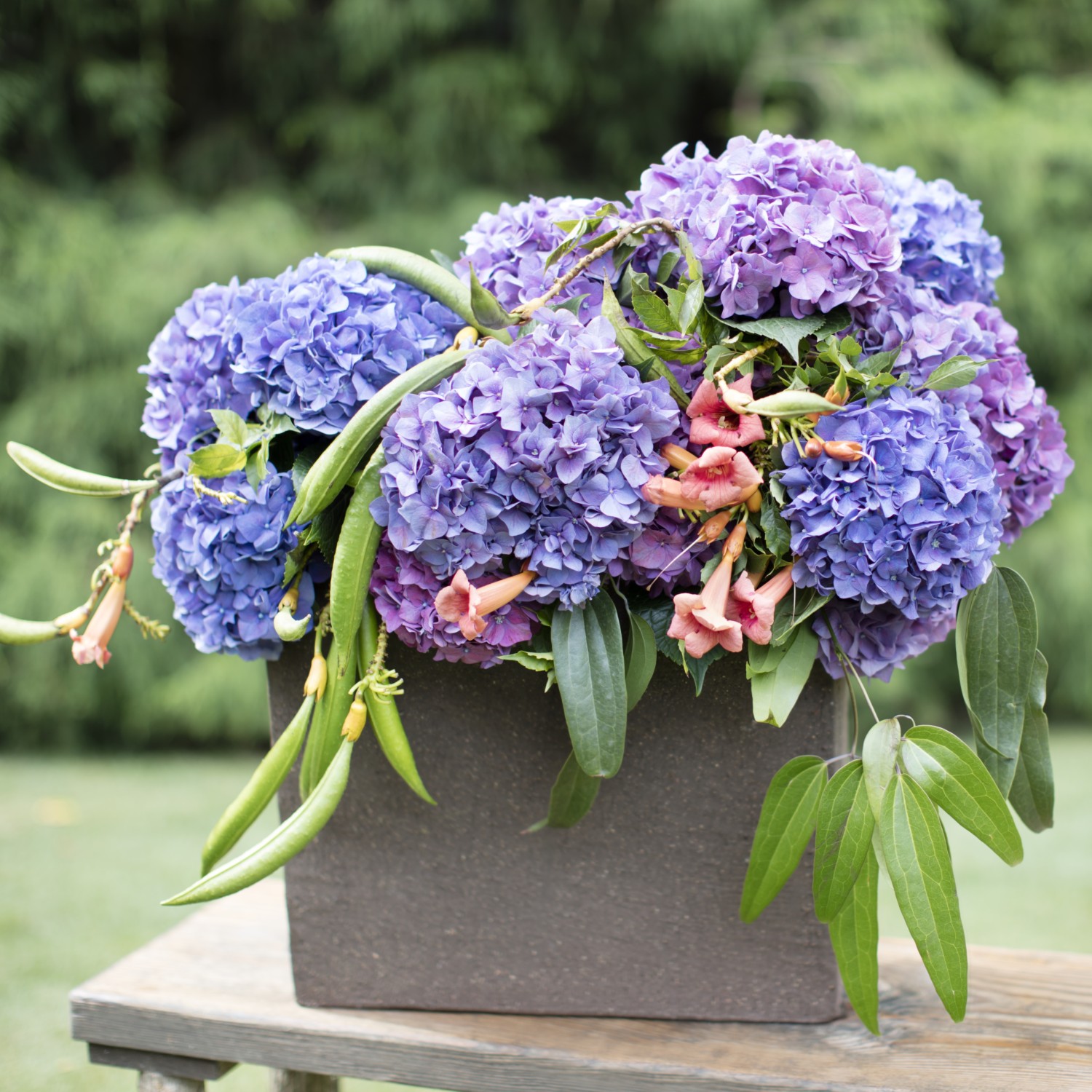
Photo by Sarah Dorio
Pollen in Atlanta created this arrangement that is the epitome of southern summers with ‘Nikko Blue’ hydrangeas, trumpet vines, and evergreen clematis foliage.
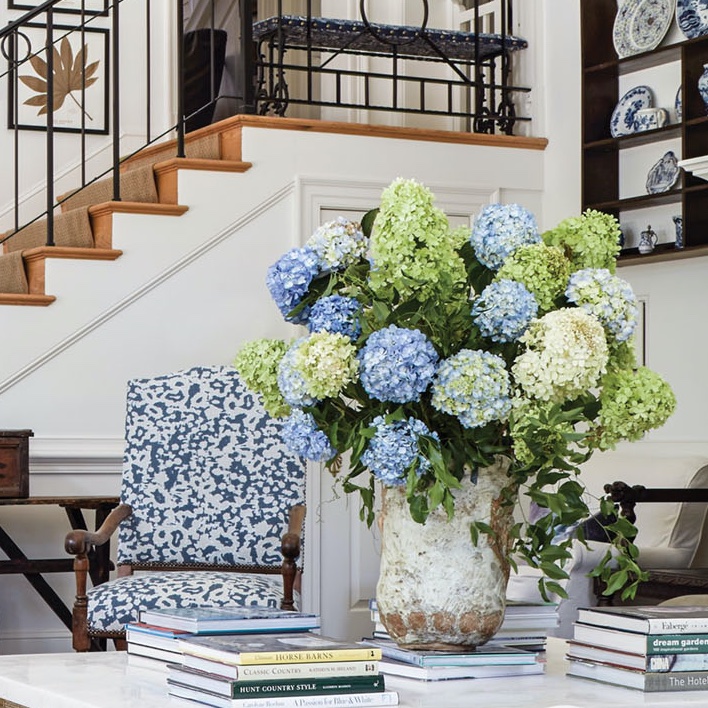
Photo by Kip Dawkins
A large ceramic jar of French blue, white, and green hydrangea blossoms in a Janie Molster designed room.
As far as cut flowers are concerned, hydrangeas are legendary. At one point, there was a showdown between the slitters and the smashers (of hydrangea stems, that is). Slitting the woody stem has pretty much won out as the chosen method to keep hydrangeas from wilting. In her recent Hydrangeas book, Naomi Slade suggests several methods to keep fresh hydrangeas looking perky, including cutting the stem at an angle while submerged in water, removing foliage, and laying moist paper towels over the flowerheads. Dried hydrangeas are also an option, achieved by simply hanging the plump corymbs upside down in a dry atmosphere. Note should be taken that hydrangeas are poisonous to humans, cats, dogs, etc. Unfortunately, this does not seem to translate to deer who pose a significant threat to the beauty, symmetry, and flower display of your coveted hydrangeas.
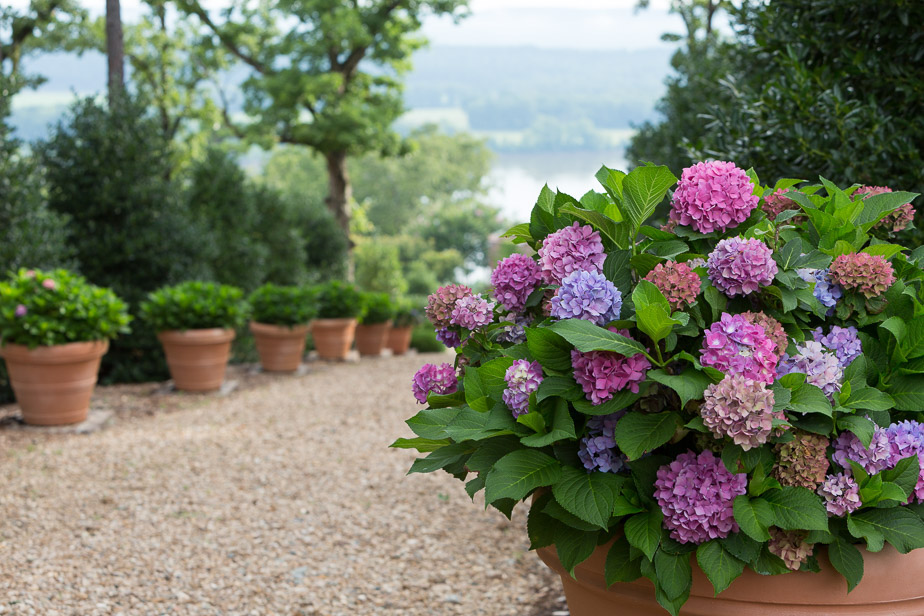
Photo by Nancy Nolan
Hydrangeas in terracotta pots line a walkway overlooking the Arkansas River at Moss Mountain Farm.
The message from all points is that bigleaf hydrangeas have a bright future ahead. For everyone who yearned to grow these buxom beauties, there’s hope. For admirers who want to visit the flowers on vacation, there’s plenty of opportunity. And for everyone who needs an arrangement close by, there’s advice. You need a little surreality in your life.



